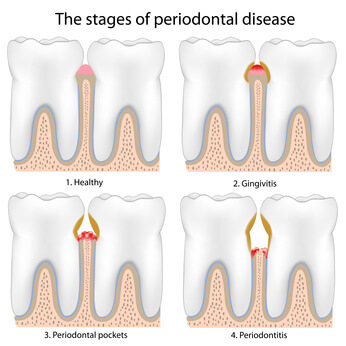
Periodontal or gum disease, is the most common cause of tooth loss in adults and is an infection caused by plaque. Plaque is the sticky film composed mostly of bacteria that forms continuously on the teeth and must be removed daily to prevent tooth decay and gum disease. If not removed, plaque bacteria produce toxins that irritate gum tissues causing them to swell. Gradually, plaque hardens into calculus (tartar), that forms a rough surface on which more plaque accumulates, causing increased irritation and swelling.
This inflammation damages the periodontal fibres that hold the gums tightly against the teeth, creating spaces known as periodontal pockets. These pockets create room for even more bacterial activity which creates deeper pockets until eventually the bone supporting the tooth is destroyed, resulting in tooth loss. In addition to plaque, other factors that can cause periodontal disease include local irritants, such as smoking, chewing tobacco, or habitually clenching the teeth. Nutrition, certain medications, and high levels of stress can also be contributing factors.
In many cases periodontal disease begins at an early age and in its first stages is called gingivitis (gum inflammation); with the more advanced stage known as periodontitis. Because the disease can be virtually painless, it is important to maintain regular check-ups so that your dentist can detect the presence of periodontal disease, however, he/she may refer you to a periodontist (a specialist in diagnosing, treating and preventing gum disease). Your periodontist does a more in-depth examination to determine the actual extent of your periodontal disease. The disease can be controlled, however, control and treatment depend on how far the disease has progressed and how willing the patient is to accept responsibility for proper home care.
The earlier you treat periodontal disease, the easier it is to control, and the better chance you have of restoring the health of your mouth and saving your teeth.
In a healthy mouth, teeth fit snugly in their sockets, their roots surrounded by a strong foundation of gums and other supportive tissue.
If not removed regularly from teeth and gums, bacteria grow out of control and produce toxins that irritate your gums. Calculus along the gum line forms a rough surface on which plaque accumulates, causing more irritation and swelling. You may notice sore, bleeding gums or bad breath. Spaces between gum and tooth (pockets) may exist, but no bone is damaged in this mild, reversible form of periodontal disease.
The most common cause of periodontitis, plaque (and sometimes calculus) is found below the gumline. The ligaments break down and the gum detaches and pulls away from the tooth. The pockets deepen and fill with more bacteria. Supportive ligaments and bone start to show damage, resulting in loose teeth.
When periodontitis progresses to the advance stage, pockets deepen and may fill with pus. There may be swelling around the root and as bone loss increases, your teeth may lose so much support that they fall out or need to be removed to preserve the overall health of your mouth.
At home, you can be on the alert for the warning signs of periodontal disease. If you have any of the following symptoms,see your dentist at once:
Of course, the only way to confirm a diagnosis of periodontal disease is to have your mouth thoroughly examined. During an examination your gums are evaluated for bleeding, swelling, firmness, and abnormal contours by your dentist or periodontist. Your teeth are also checked for movement and sensitivity, as well as your bite (which could be a contributing factor to the condition) is also assessed.
Full mouth x-rays less than a year old are usually required to detect breakdown of bone surrounding your teeth. Periodontal probing below the gumline involves measuring and recording the depth of the pockets around each tooth, which you can’t see or feel. Probing is the key technique your dental proffesional uses to find out how serious your disease is and to plan your treatment.
A probe is like a tiny ruler. Your dental professional inserts this tool gently in the space, or pocket, between your tooth and gum. The deeper the probe goes, the deeper the pocket, and the more severe the periodontal disease.
For the healthiest gums use these formulas for brushing, flossing, massaging gums, mouth-rinses, proxa-brushes, sulca-brushes, rubber-tip stimulators to overcome sensitive teeth, to ease the recovery of oral surgery, and for general overall cavity prevention.
A beautiful smile can give patients a lifetime of happiness!
(780) 484-0808